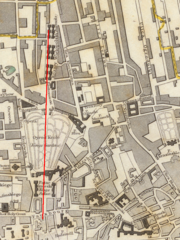
Saxon Axis
Encyclopedia

Warsaw
Warsaw is the capital and largest city of Poland. It is located on the Vistula River, roughly from the Baltic Sea and from the Carpathian Mountains. Its population in 2010 was estimated at 1,716,855 residents with a greater metropolitan area of 2,631,902 residents, making Warsaw the 10th most...
. It is a line running from the Vistula
Vistula
The Vistula is the longest and the most important river in Poland, at 1,047 km in length. The watershed area of the Vistula is , of which lies within Poland ....
through the Presidential Palace
Presidential Palace, Warsaw
The Presidential Palace in Warsaw, Poland, is the elegant classicist latest version of a building that has stood on the Krakowskie Przedmieście site since 1643. Over the years, it has been rebuilt and remodeled many times...
, the Krakowskie Przedmieście
Krakowskie Przedmiescie
Krakowskie Przedmieście is one of the most impressive and prestigious streets of Poland's capital.Several other Polish cities also have streets named Krakowskie Przedmieście. In Lublin, it is the main and most elegant street...
, Saxon Square, Saxon Palace, Saxon Garden
Saxon Garden
The Saxon Garden is a 15.5–hectare public garden in downtown Warsaw, Poland, facing Piłsudski Square. It is the oldest public park in the city...
, Lubomirski Palace
Lubomirski Palace
Lubomirski Palace is the name of several palaces of the Lubomirski family:* Lubomirski Palace, Białystok :pl:Pałac Rüdigerów w Białymstoku* Lubomirski Palace, Warsaw :pl:Pałac Lubomirskich w Warszawie*: Presidential Palace, Warsaw...
to Plac Żelaznej Bramy
Plac Zelaznej Bramy
Plac Żelaznej Bramy is a large open space in the city center of Warsaw. The square took its name from a large iron gate that once secured the western boundary of the Saxon Garden.- History :...
.
The idea was first proposed by August II of Poland, who intended to build a large Royal palace surrounded by a French-style garden. The plan was loosely based on the baroque
Baroque
The Baroque is a period and the style that used exaggerated motion and clear, easily interpreted detail to produce drama, tension, exuberance, and grandeur in sculpture, painting, literature, dance, and music...
design of the Versailles
Versailles
Versailles , a city renowned for its château, the Palace of Versailles, was the de facto capital of the kingdom of France for over a century, from 1682 to 1789. It is now a wealthy suburb of Paris and remains an important administrative and judicial centre...
and was to cover a large part of what is now the city of Warsaw. The main concept, which gave the name to the modern part of the city, assumed the construction of the Saxon Palace, with gardens extending to the both sides along a single axis running exactly through its middle.
Between 1713 and 1726 the king bought 28 various parcels located in the area and invited Matthäus Daniel Pöppelmann
Matthäus Daniel Pöppelmann
Matthäus Daniel Pöppelmann was a German master builder who helped to rebuild Dresden after the fire of 1685, and designed Dresden Castle and the Pillnitz church.Pöppelmann was born in Herford...
and Johann Christoph Naumann
Johann Christoph Naumann
Johann Christoph Naumann was the urban designer who, with Matthäus Daniel Pöppelmann, designed portions of the city of Warsaw, Poland, including the Saxon Axis and other important streetscapes....
to design the urban plan. However, financial difficulties made the plan never come true in its entirety. Although the Saxon Garden
Saxon Garden
The Saxon Garden is a 15.5–hectare public garden in downtown Warsaw, Poland, facing Piłsudski Square. It is the oldest public park in the city...
and the Saxon Palace were constructed, the planned demolition of the Lubomirski Palace at the Plac Żelaznej Bramy
Plac Zelaznej Bramy
Plac Żelaznej Bramy is a large open space in the city center of Warsaw. The square took its name from a large iron gate that once secured the western boundary of the Saxon Garden.- History :...
had to be called off after August's death in 1733.
During the World War II
World War II
World War II, or the Second World War , was a global conflict lasting from 1939 to 1945, involving most of the world's nations—including all of the great powers—eventually forming two opposing military alliances: the Allies and the Axis...
and the Warsaw Uprising
Warsaw Uprising
The Warsaw Uprising was a major World War II operation by the Polish resistance Home Army , to liberate Warsaw from Nazi Germany. The rebellion was timed to coincide with the Soviet Union's Red Army approaching the eastern suburbs of the city and the retreat of German forces...
of 1944, all of the buildings located along the axis were demolished by the Germans
Germany
Germany , officially the Federal Republic of Germany , is a federal parliamentary republic in Europe. The country consists of 16 states while the capital and largest city is Berlin. Germany covers an area of 357,021 km2 and has a largely temperate seasonal climate...
. After the war, the Saxon Palace was not rebuilt. However, the garden was refurbished and the demolished Lubomirski Palace was rebuilt, but was rotated to fit into the 18th century scheme. In recent times also the Warsaw University Library located at the Vistula
Vistula
The Vistula is the longest and the most important river in Poland, at 1,047 km in length. The watershed area of the Vistula is , of which lies within Poland ....
below the river escarpment was added to the list of buildings with main entrances located along the axis, and there was a large golden tablet placed in the pavement in front of it marking the line running through the city centre.

